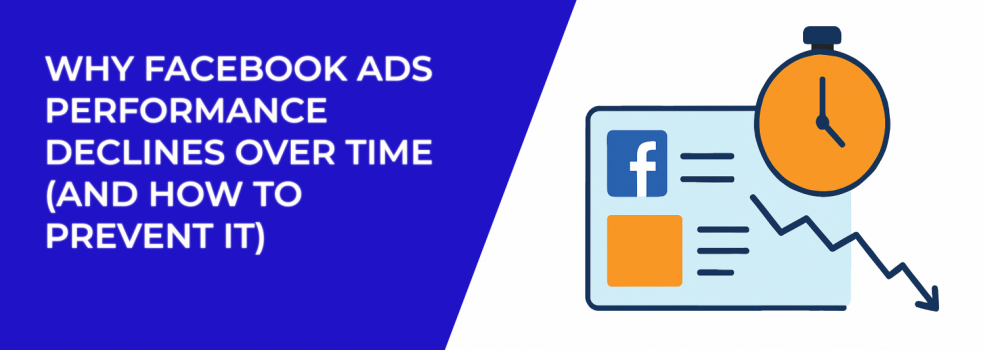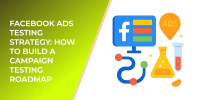Facebook Ads rarely stay strong forever. A campaign might launch with great numbers — high engagement, low costs, and solid conversions — only to fade weeks later. This drop is frustrating, but it’s not random. It happens because of audience fatigue, competitive pressure, and how the platform allocates spend.
The key isn’t to hope your ads will last longer than others. It’s to understand why performance declines and to apply strategies that keep results stable.
The Inevitable Decline of Ad Performance
At first, Facebook Ads can feel unstoppable — low CPMs, high engagement, steady conversions. But after a few weeks, costs rise, CTR drops, and results weaken.
This decline isn’t random. It’s a natural effect of how the platform works and how audiences behave. The good news? You can anticipate it and take action before performance falls too far.
The Main Reasons Ads Lose Steam
1. Audience Fatigue
When the same people see your ad too often, attention fades. A frequency of 1–2 builds awareness, but at 4–5, most users scroll past. Some even hide or report the ad, lowering relevance scores and driving up CPMs.
For small, narrow audiences, fatigue happens faster because the same users cycle through impressions repeatedly. That’s why campaigns targeting niche groups often decline within days instead of weeks. If you want to dive deeper into spotting and fixing this issue, check out Ad Fatigue on Facebook: How to Spot It Early and Fix It Fast.
2. Rising Competition in the Auction
Every impression is decided in an auction. If more advertisers compete for the same group — for example, “business decision-makers” or “fitness enthusiasts” — costs rise.
This is especially visible in high-demand periods like Black Friday or tax season, when CPMs can double. Even if your ad quality stays strong, your budget simply buys less reach, which weakens performance over time. To understand how auction pressure works, see Crack the Code: What You Need to Know About the Facebook Ad Auction.
3. Creative Burnout
Creatives lose impact the longer they run. A polished product shot may stand out at launch but blend in by week three. Video ads hold attention longer, but they too lose power when audiences see the same story loop again and again.
Context matters too. Seasonal shifts, cultural events, or market changes can make ads feel outdated if creatives aren’t refreshed to match the moment. For a structured approach to building variety, see The Ultimate Guide to Facebook Ad Formats.
4. Weak Optimization Over Time
Facebook’s algorithm is efficient, but it needs direction. Left unchecked, it may push budget toward placements that deliver impressions but no conversions, or continue spending on an audience that is already saturated.
Without regular adjustments — to bids, placements, and targeting — small inefficiencies build up. Over weeks, they compound into wasted spend and falling ROI. If your ads are “stuck,” this guide can help: How to Finish the Facebook Learning Phase Quickly.
How to Prevent the Decline
Rotate Creatives on a Schedule
Many advertisers underestimate how quickly audiences tire of seeing the same visuals. A structured rotation prevents fatigue and gives the algorithm new material to test. Instead of scrambling when performance drops, prepare in advance:
-
Launch with variety: Have 3–5 creative variations ready from the start.
-
Mix formats: Don’t rely only on static images — include videos, carousels, and UGC-style content.
-
Refresh regularly: For cold audiences, aim to update creatives every 10–14 days or whenever frequency exceeds 3.
-
Track results closely: Monitor creative-level performance and cut underperformers quickly.
This isn’t just about staying fresh — it’s about creating a library of insights on what resonates best with your audience.
Expand and Segment Audiences Strategically
Targeting the same audience repeatedly guarantees diminishing returns. Growth comes from balancing expansion with relevance. Here’s how to keep reach broad without losing precision:
-
Use lookalikes: Build audiences from your top converters to reach fresh but similar users.
-
Segment by funnel stage: Run awareness ads for cold audiences, retargeting campaigns for warm ones, and upsell ads for existing customers.
-
Exclude smartly: Always exclude recent buyers or website visitors from acquisition ads to avoid wasting impressions.
-
Layer targeting: Combine demographics, interests, and behaviors to uncover micro-niches.
For a full breakdown, see Facebook Ad Targeting 101: How to Reach the Right Audience.
Watch Frequency and Engagement Metrics Closely
Frequency is one of the clearest indicators of when performance will decline, but it doesn’t tell the full story on its own. Pair it with engagement metrics to catch issues early:
-
Check trends, not just numbers: If frequency rises while CTR drops, fatigue is taking hold.
-
Automate alerts: Set rules in Ads Manager to notify you when frequency passes your threshold.
-
Act quickly: Refresh creatives, expand audiences, or cap impressions before costs spike further.
To go deeper, see How Frequency Capping Helps Beat Facebook Ad Fatigue.
Optimize Budgets and Placements
Leaving budgets and placements fully automated is convenient but risky. The algorithm doesn’t know your priorities — you do. Protect efficiency by monitoring where your money goes:
-
Review placements weekly: If Facebook Feed delivers conversions at half the cost of Audience Network, shift budget accordingly.
-
Test budget types: Compare campaign budget optimization (CBO) with ad set budgets (ABO) to see which allocates better for your goals.
-
Adapt bids: During high-competition seasons, test cost caps or bid caps to control rising CPMs.
Hands-on adjustments ensure that spend goes where it matters most.
Build a Continuous Testing Framework
Testing is the antidote to decline. Without it, campaigns stagnate. But effective testing goes beyond just swapping an image or two:
-
Creative testing: Rotate different headlines, hooks, and CTAs to see what sparks attention.
-
Offer testing: Compare discounts, bundles, or limited-time promos to learn what motivates buyers.
-
Landing page testing: Improve conversion by aligning page content with ad promises.
-
Funnel testing: Experiment with timing, sequencing, and messaging in retargeting flows.
Treat testing as a system, not a task. Every experiment adds to your knowledge base and sharpens long-term strategy.
Staying Ahead of the Curve
Declining performance isn’t failure — it’s feedback. Ads lose momentum because audiences adapt, competition shifts, and creatives age. The advertisers who succeed aren’t the ones who avoid decline but the ones who recognize it early and adapt quickly.
Instead of asking whether your ads will decline, ask when — and whether you’ll be ready to pivot. The best results come from systems that keep campaigns evolving: rotating creatives, refreshing audiences, and optimizing spend.
So the question is: will you wait until performance crashes, or will you act before the decline costs you more than it should?

